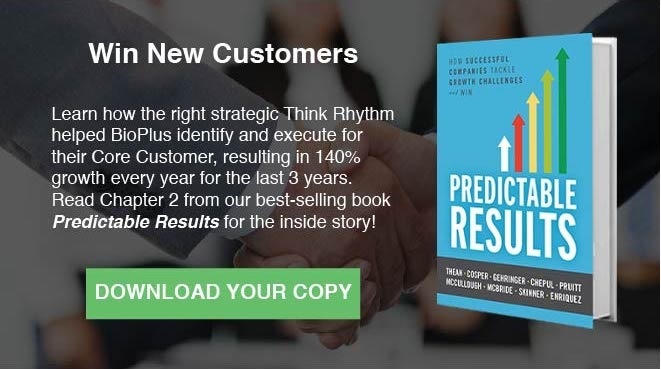I have written previously about the importance of Identifying your core customer because I have seen far too many companies waste their valuable time and resources selling to and serving the "wrong" customers. They haven't taken the necessary steps to identify their most valuable customers who purchased the primary product and were highly satisfied.
Your core customer is the one who values what you offer at a price and quantity that is good for both you and the customer and will take you into the future successfully. This is the individual that uses the product, the one you look in the eyes and can put a name to, and the one you can’t live without. Knowing who the core customer is will positively impact sales.
Not knowing your primary customer can result in a lot of problems: customer turnover, unhappy customers, customers you lose money on, and limited growth and profitability. To make sure you are clear about who your core customer is, you must be able to describe them as a living, breathing person - a person you can get to know, develop a relationship with, and form a mental picture of. You don’t sell your product or service to a demographic, you sell it to a real person.
Some companies have only one core customer, and this is the one who purchases the product or service and uses it. You must do the critical work to identify this person very carefully to fully understand him and his needs so you can uniquely fulfill them. Ultimately, you want to delight these customers so that they become raving fans and tell others to buy your product. Just because someone is a potential customer, doesn't mean that they will be a profitable customer that will stay in your customer base for years to come and have the best customer experience.
Other companies do not have it quite so easy, and this is where it gets a bit more complicated. The individual who uses the product or service may not be the same one making the purchasing decision. In this situation, we need to make sure we understand both the primary and the secondary customers. Their needs may be very different. It may be simpler to think of it in terms of the user (primary) and the buyer (secondary). No matter if you are a small business or a large corporation, identifying your core customer is one of the best things you can do to drive the enterprise value of your potential customers while scaling up your business. Clearly defining your primary and secondary customers will increase your ability to deliver profits (primary customers will pay a premium price) and predictable results.
The primary customer is the one we appeal to to create the pull for our offering; they must have what you provide. Apple does a great job of this and I can tell you, my sons are always asking for the latest and greatest offering Apple introduces. The only problem is they do not quite have the means to purchase all these wonderful products on their own. That’s where Dad comes in as the secondary customer or buyer. Apple also must satisfy my needs so that I see the value in purchasing their products at a premium price. One of the ways they do this is by providing a longer life span for the product which enhances its value. Additionally, their products all integrate well and provide some communication benefits for the family. The security is tighter and requires less intervention to address viruses. The hardware is very tightly integrated with the software and requires less overall maintenance and repair. We have Apple devices going five years strong with proper care and use.
I also use the example in manufacturing, where the design engineer, or primary customer, specifies the parts to be used in a product. They are taking into consideration overall design integrity, designing for manufacturability, long-term performance, and lasting quality. All very important needs. The secondary customer is purchasing, and their needs are very different. They are looking at pricing, availability, lead times, replenishment times, minimum order quantities, vendor-managed inventories, freight costs, and the list goes on. The sale will not be made if both customers are not completely satisfied.
Questions to Identify Your Primary Customer
- What do we believe our primary customers value?
- What are our customers' long-term goals and aspirations?
- What creates customer happiness?
- What delights them?
- What are their needs, not wants?
- What will make them successful in their jobs?
- What problem can your offering solve?
- What pain can you eliminate?
- What are their risk factors?
- Are they in your primary sector?
- What do our important customers have in common?
- Would they like our primary product, or do we need to make alterations?
- What product-based changes can you make to deliver more perceived value to them?
The primary customer may create the pull-through for your offering, but if the secondary customers’ needs are not met, the sale may never be made.
Questions to Identify Your Secondary Customer
- Who else must be satisfied?
- Who purchases the product?
- Who generates cash?
- Are they the ultimate decision maker?
- Who else plays a role in the decision-making process?
- What are their needs?
- What will make them successful in their role?
- When is it important to focus on the secondary customer?
- Why is it important to understand the secondary customer?
Determining if you have more than one core customer and then taking the time to identify both will dramatically increase your success. As the great Peter Drucker said, “The purpose of a company is to create a customer… the only profit center is the customer.” This is a process that is very common for companies to dismiss, but extremely important for long-term success. Being able to identify customers that generate the most revenue and profit potential is one of the best things you can do
There is a lot more work to nail down your core customers, but this will get you started down the right path. So please give some thought to your core customer and determine if you have one or if you have a primary and secondary. Then, get to work identifying who they are and what their needs are.




